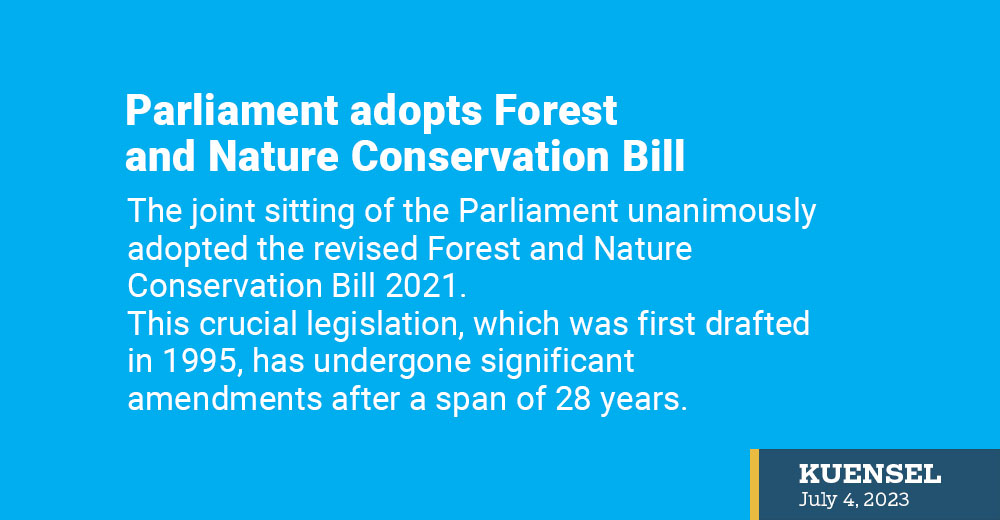Choki Wangmo
The joint sitting of the Parliament unanimously adopted the revised Forest and Nature Conservation Bill 2021.
This crucial legislation, which was first drafted in 1995, has undergone significant amendments after a span of 28 years.
During the deliberations on June 30, the joint committee thoroughly examined the 30 of the Bill’s disputed clauses, with particular focus on sections 50 (5) and the newly proposed section after section 47.
The National Assembly put forth a new section after section 47 during the previous session of Parliament. The proposed section stated: “Where any tree endangers or obstructs the passage of vehicles or pedestrians or interferes with the view of drivers, the Department may facilitate trimming or cutting it to remove the cause of danger, obstruction, or interference.”
However, the House of Review recommended the removal of this new section.
Following thorough consideration, the joint committee accepted the recommendations put forth by the National Council (NC), reasoning that the proposed section was redundant.
The NC member from Paro, Ugyen Tshering, highlighted concerns that the new section might come in conflict with the provisions outlined in the Road Act. Consequently, the joint committee decided that the issue of trees obstructing roads is adequately addressed in other sections of the Bill.
During the deliberations on June 30, several MPs raised concerns about the removal of the new section. MP Yeshey Dem from Khamed-Lunana, Tshering Chodden from Khar-Yurung, and Kinga Penjor from Gangzur-Minjey expressed their apprehensions and shared instances of challenges faced by the public during the monsoon season when they are not allowed to clear or cut trees blocking the roads. They highlighted the difficulties faced in areas that do not fall under the jurisdiction of the Department of Roads.
Another contentious clause within the Bill was section 50 (5). The original article states that settlement within 500 metres of the plinth of monasteries or dzongs is prohibited, with exceptions made for the construction of access roads and power supply lines. In addition to these exceptions, the joint committee recommended the inclusion of “other developmental activities” in the clause. However, MPs expressed concerns that this phrase could lead to misinterpretation.
MP for Drametse-Ngatsang, Ugyen Wangdi, argued that the mention of “other developmental activities” was unnecessary. Furthermore, other MPs emphasised that allowing the construction of structures within 500 metres of monasteries or dzongs could lead to unregulated development in close proximity to these sacred sites.
The joint committee members said that the “other developmental activities” meant those activities related to dzongs and monasteries.
The unanimous adoption of the revised Forest and Nature Conservation Bill marks a significant milestone in Bhutan’s efforts to safeguard its natural heritage while ensuring responsible development and the preservation of sacred sites.
The revised legislation reflects a collective commitment to strike a balance between conservation and the needs of the people.
The Bill was introduced in December last year.


